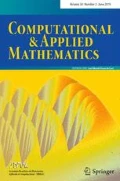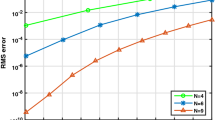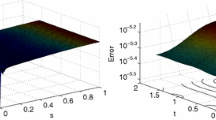Abstract
Meshfree techniques based on infinitely smooth radial kernels have the great potential to provide spectrally accurate function approximations with irregular domain in high dimensions. The maximum accuracy can mostly be found when the RBF shape parameter is small, i.e., when the radial kernel is relatively smooth. However, as the shape parameter goes to zero, the standard RBF interpolant matrix will be very ill-conditioned. The ill-conditioning can be alleviated using alternate bases. One of these alternative bases is the Hilbert–Schmidt SVD basis. The Hilbert–Schmidt SVD approach suggests a stable mechanism for replacing a set of near-flat kernels with scattered centres to a well-conditioned base for exactly the same space. In this work, the Gaussian Hilbert–Schmidt SVD basis functions method is presented to numerically solve the linear two-dimensional Fredholm integral equations of the second kind. The method estimates the solution by the discrete collocation method based on Gaussian Hilbert–Schmidt SVD basis functions constructed on a set of scattered points. The emerged integrals in the scheme are approximately computed by the Gauss–Legendre quadrature rule. This approach reduces the problem under study to a linear system of algebraic equations which can be solved easily via applying an appropriate numerical technique. Also, the convergence of the proposed approach is established. Finally, numerical results are compared with standard RBF method to indicate the accuracy and efficiency of the suggested approach.








Similar content being viewed by others
References
Almasieh H, Nazari Meleh J (2014) Numerical solution of a class of mixed two-dimensional nonlinear Volterra–Fredholm integral equations using multiquadric radial basis functions. J Comput Appl Math 260:173–179
Assari P, Dehghan M (2017) A meshless method for the numerical solution of nonlinear weakly singular integral equations using radial basis functions. Eur Phys J Plus 132:1–23
Assari P, Dehghan M (2017) The numerical solution of two-dimensional logarithmic integral equations on normal domains using radial basis functions with polynomial precision. Eng Comput 33(4):853–870
Assari P, Adibi H, Dehghan M (2013) A numerical method for solving linear integral equations of the second kind on the non-rectangular domains based on the meshless method. Appl Math Mod 37:9269–9294
Assari P, Adibi H, Dehghan M (2013) A meshless method for solving nonlinear two-dimensional integral equations of the second kind on non-rectangular domains using radial basis functions with error analysis. J Comput Appl Math 239:72–92
Atkinson K (1997) The numerical solution of integral equations of the second kind, vol 4. Cambridge University Press, Cambridge
Boersma J, Danicki E (1993) On the solution of an integral equation arising in potential problems for circular and elliptic disks. SIAM J Appl Math 53:931–941
Bremer J, Rokhlin V, Sammis I (2010) Universal quadratures for boundary integral equations on two-dimensional domains with corners. J Comput Phys 229:8259–8280
Cavoretto R, Fasshauer GE, McCourt M (2015) An introduction to the Hilbert–Schmidt SVD using iterated Brownian bridge kernels. Numer Algorithm 68(2):393–422
De Marchi S, Santin G (2013) A new stable basis for radial basis function interpolation. J Comput Appl Math 253:1–13
Dobner HJ (1987) Bounds for the solution of hyperbolic problems. Computing 38:209–218
Esmaeilbeigi M, Mirzaee F, Moazami D (2017) Radial basis functions method for solving three-dimensional linear Fredholm integral equations on the cubic domains. Iran J Numer Anal Optim 7(2):15–38
Esmaeilbeigi M, Mirzaee F, Moazami D (2017) A meshfree method for solving multidimensional linear Fredholm integral equations on the hypercube domains. Appl Math Comput 298:236–246
Esmaeili H, Moazami D (2019) A kernel-based technique to solve three-dimensional linear Fredholm integral equations of the second kind over general domains. Comput Math Appl. https://doi.org/10.1007/s40314-019-0959-5
Farengo R, Lee YC, Guzdar PN (1983) An electromagnetic integral equation: application to microtearing modes. Phys Fluids 26:3515–3523
Fasshauer GE (1997) Solving partial differential equations by collocation with radial basis functions. In: Le Mhaut A, Rabut C, Schumaker LL (eds) Surface fitting and multiresolution methods. Vanderbilt University Press, Nashville, pp 131–138
Fasshauer GE (2007) Meshfree approximation methods with MATLAB, Interdisciplinary Mathematical Sciences, vol 6. World Scientific Publishing Company, Singapore
Fasshauer GE, McCourt M (2012) Stable evaluation of Gaussian RBF interpolants. SIAM J Sci Comput 34(2):737–762
Fasshauer GE, McCourt MJ (2015) Kernel-based approximation methods using matlab. World Scientific, Singapore
Fasshauer G, Zhang J (2009) Preconditioning of radial basis function interpolation systems via accelerated iterated approximate moving least squares approximation, computational methods in applied sciences, vol 11. Springer, Netherlands
Fornberg B, Zuev J (2007) The Runge phenomenon and spatially variable shape parameters in RBF interpolation. Comput Math Appl 54(3):379–398
Fornberg B, Larsson E, Flyer N (2011) Stable computations with gaussian radial basis functions. SIAM J Sci Comput 33(2):869–892
Fornberg B, Lehto E, Powell C (2013) Stable calculation of Gaussian-based RBF-FD stencils. Comput Math Appl 65(4):627–637
Franke C, Schaback R (1998) Solving partial differential equations by collocation using radial basis functions. Appl Math Comput 93(1):73–82
Golbabai A, Seifollahi S (2006) Numerical solution of the second kind integral equations using radial basis function networks. Appl Math Comput 174:877–883
Kansa EJ (1990) Multiquadrics—a scattered data approximation scheme with applications to computational fluid dynamics-I. Comput Math Appl 19:127–145
Kansa EJ (1990) Multiquadrics—a scattered data approximation scheme with applications to computational fluid dynamics-II. Comput Math Appl 19:147–161
Li XF, Rong EQ (2002) Solution of a class of two-dimensional integral equations. J Comput Appl Math 145:335–343
Mirkin MV, Bard AJ (1992) Multidimensional integral equations: a new approach to solving microelectrode diffusion problems. J Electroanal Chem 323:29–51
Narcowich FJ, Ward JD (1991) Norms of inverses and condition numbers for matrices associated with scattered data. J Approx Theory 64:69–94
Narcowich FJ, Sivakumar N, Ward JD (1994) On condition numbers associated with radial-function interpolation. J Math Anal Appl 186:457–485
Parand K, Rad JA (2012) Numerical solution of nonlinear Volterra–Fredholm–Hammerstein integral equations via collocation method based on radial basis functions. Appl Math Comput 218:5292–5309
Pazouki M, Schaback R (2011) Bases for kernel-based spaces. J Comput Appl Math 236(4):575–588
Radlow J (1964) A two-dimensional singular integral equation of diffraction theory. Bull Am Math Soc 70:596–599
Sarra S, Sturgill D (2009) A random variable shape parameter strategy for radial basis function approximation methods. Eng Anal Bound Elem 33(11):1239–1245
Wendland H (2005) Scattered data approximation, Cambridge Monographs on Applied and Computational Mathematics, vol 17. Cambridge University Press, Cambridge
Wu ZM (1992) Hermite–Birkhoff interpolation of scattered data by radial basis functions. Approx Theory Appl 8(2):1–10
Author information
Authors and Affiliations
Corresponding author
Additional information
Communicated by Hui Liang.
Publisher's Note
Springer Nature remains neutral with regard to jurisdictional claims in published maps and institutional affiliations.
Rights and permissions
About this article
Cite this article
Esmaeili, H., Moazami, D. Application of Hilbert–Schmidt SVD approach to solve linear two-dimensional Fredholm integral equations of the second kind. Comp. Appl. Math. 39, 123 (2020). https://doi.org/10.1007/s40314-020-01150-6
Received:
Revised:
Accepted:
Published:
DOI: https://doi.org/10.1007/s40314-020-01150-6
Keywords
- Two-dimensional Fredholm integral equation
- Linear integral equation
- Hilbert–Schmidt SVD method
- Numerical stability
- Gaussian radial basis function




